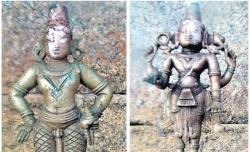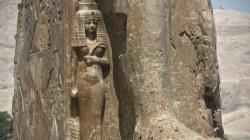INSTITUT SUPERIEUR D'ANTHROPOLOGIE
INSTITUTE OF ANTHROPOLOGY
ONLINE COURSES / COURS A DISTANCE
WINTER TERM : JANUARY 2015
REGISTER NOW
INDE –  Belanje - T. Murugeshi, associate professor in ancient history and archaeology, M.S.R.S. College, Shirva, recently found two bronze icons dating back to the Vijayanagar period. The icons of Lord Vittala and Lord Janardhana were found at the Janardhana temple in Belanje village near Hebri in Karkala taluk, he said in a press release here on Wednesday. Both the icons appear to belong to the early Vijayanagar period, that is 14th century A.D. The icons are mentioned in the dated, but incomplete, inscription found in the temple. The inscription dates back to Saka year 1326, which is 1404 A.D. It refers to the icon as Lord Vittala, which was worshipped by Bhodhana Tirtha Swami, a disciple of Sripada Odeya Swami of Kangu Math. It mentions Pandarideva as the Governor of Barkur province under Harihara II of the Vijayanagar dynasty. The inscription states the direction given by a prince, Mallikarjuna, to provide 630 gold coins and nine ‘murras’ of rice to the temple for the purpose of worshipping Lord Vittala at Brelinje, which is the present day Belanje village. (One ‘murra’ of rice is equal to 38 kg). The icon of Lord Vittala is 28 cm in height and stands on a lotus pedestal in ‘samabhanga’ posture, while the icon of Lord Janardhana is 18 cm in height and stands on a ‘padma-peetha’ in ‘samabhanga’ posture. “From the standpoint of iconography and chronology, the icon of Lord Vittala is a good specimen for study,” Prof. Murugeshi said.
Belanje - T. Murugeshi, associate professor in ancient history and archaeology, M.S.R.S. College, Shirva, recently found two bronze icons dating back to the Vijayanagar period. The icons of Lord Vittala and Lord Janardhana were found at the Janardhana temple in Belanje village near Hebri in Karkala taluk, he said in a press release here on Wednesday. Both the icons appear to belong to the early Vijayanagar period, that is 14th century A.D. The icons are mentioned in the dated, but incomplete, inscription found in the temple. The inscription dates back to Saka year 1326, which is 1404 A.D. It refers to the icon as Lord Vittala, which was worshipped by Bhodhana Tirtha Swami, a disciple of Sripada Odeya Swami of Kangu Math. It mentions Pandarideva as the Governor of Barkur province under Harihara II of the Vijayanagar dynasty. The inscription states the direction given by a prince, Mallikarjuna, to provide 630 gold coins and nine ‘murras’ of rice to the temple for the purpose of worshipping Lord Vittala at Brelinje, which is the present day Belanje village. (One ‘murra’ of rice is equal to 38 kg). The icon of Lord Vittala is 28 cm in height and stands on a lotus pedestal in ‘samabhanga’ posture, while the icon of Lord Janardhana is 18 cm in height and stands on a ‘padma-peetha’ in ‘samabhanga’ posture. “From the standpoint of iconography and chronology, the icon of Lord Vittala is a good specimen for study,” Prof. Murugeshi said.
http://www.thehindu.com/news/cities/bangalore/14th-century-bronze-idols-discovered/article6683438.ece
USA – Superior - A centuries-old Native American burial site has been uncovered along U.S. Highway 60 in Superior, including the remains of at least nine people and evidence of 40 rooms that once stood there.The remains — discovered between this spring and October — likely date to the 14th century and represent the Salado people, who were made up of a mix of cultures. The U.S. National Park Service said the Salado are an extension of the Hohokam, who used irrigation canals to farm in the Salt and Gila River valleys, beginning thousands of years ago. The Hohokam and Salado population there decreased drastically between 1350 and 1450, likely because of drought. Those who remained are the ancestors of today’s Gila and Salt River communities, says the Arizona Museum of Natural History.
http://tucson.com/news/prehistoric-burial-site-found-near-superior/article_abace951-9f09-5375-8325-6dc4206706ab.html?
EGYPTE –  Louxor - The tomb of a queen from ancient Egypt's Ramesside Period has been discovered in Luxor by a joint team of Egyptian and French archaeologists. "Research is continuing to determine the name of the pharaoh she was married to," a statement issued by the antiquities ministry said. During the Ramesside Period -- the Nineteenth Dynasty (1314-1200 BC) and Twentieth Dynasty (1200-1085 BC) -- 11 kings were named Rameses. Inside the tomb, archaeologists found fragments from 20 funerary statues on which was inscribed the name "Karomama", which may help narrow the search. Finding this vital clue "will help establish more about this important person", the ministry said.
Louxor - The tomb of a queen from ancient Egypt's Ramesside Period has been discovered in Luxor by a joint team of Egyptian and French archaeologists. "Research is continuing to determine the name of the pharaoh she was married to," a statement issued by the antiquities ministry said. During the Ramesside Period -- the Nineteenth Dynasty (1314-1200 BC) and Twentieth Dynasty (1200-1085 BC) -- 11 kings were named Rameses. Inside the tomb, archaeologists found fragments from 20 funerary statues on which was inscribed the name "Karomama", which may help narrow the search. Finding this vital clue "will help establish more about this important person", the ministry said.
http://www.9news.com.au/technology/2014/12/12/09/41/tomb-of-pharaoh-queen-found-in-egypt?